The Muslim Quarter in the ancient Silk Road city is being swallowed by tourism and development, but some local food lovers are trying to keep the old traditions alive.
It’s a scorching day in July in the ancient Silk Road city of Xi’an, with highs of 108 degrees Fahrenheit and a heat index somewhere between broiling and roasting. I’ve realized far too late that it’s not wise to visit Xi’an in the summer. The mostly Han Chinese tourists in the city’s old Muslim Quarter look absolutely miserable trudging beneath umbrellas in the relentless sun. Inside the air-conditioned McDonald’s, diners slump over greasy tables, looking as if they’ve been drugged.
Feeling woozy myself, I’m not exactly looking forward to a steaming bowl of paomo, the hearty stew of lamb and chunks of unleavened bread that Xi’an is famous for. If ever there was a dish best served in the winter, this is it. But here I am, about to eat my second bowl of the day, getting schooled on the finer points of the dish by a food blogger who goes by the online nickname Yao Ge, or “Demon Brother.”
We settle in at a popular restaurant where patrons are bent low over bowls of soup and the floor is littered with used napkins. If you give a damn about your paomo, Demon Brother says, you respect the ceremony that surrounds it. And here, it’s the customer who’s responsible for tearing the chunks of bread that go in the soup, not the chef.
“Although we usually say ‘bai mo’ (tear the bread), it’s actually more like ‘qia mo’ (pinch the bread),” an increasingly animated Demon Brother bellows, even though I’m sitting a mere two feet away. “Use the fingernails to pinch it—the pieces should be the size of a bee’s head.”
As we pinch our bread over our empty bowls, Demon Brother tells me what will happen next. After the bread is shredded, the bowls are sent back to the kitchen where the chef adds bone stock, slices of lamb, coriander, and vermicelli noodles, and then blasts it over a jet-engine flame for several minutes. In the most traditional paomo establishments, the quality of the cooking corresponds directly with the quality of the prep work done at the table, he says. An eagle-eyed chef can spot a lazy bread pincher, and if the pieces aren’t uniform, a proud Xi’an chef may respond be taking less care on his end, as if to say: If you aren’t going to treat the dish with the respect it deserves, neither will I.
I look down at the uneven chunks of bread my bowl. Some are the size of a mouse’s head. I’ve carelessly raced through the sacred exercise.
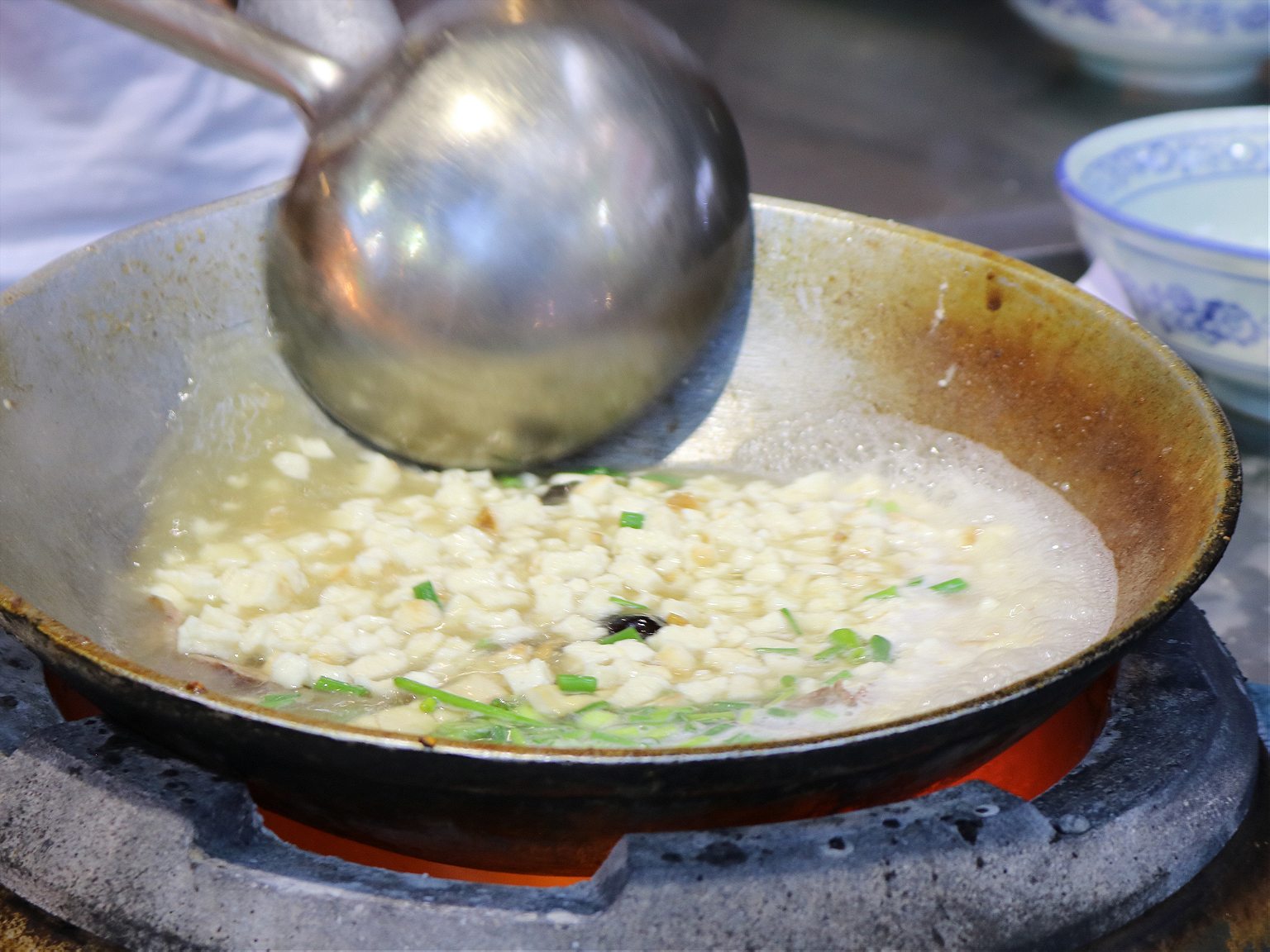
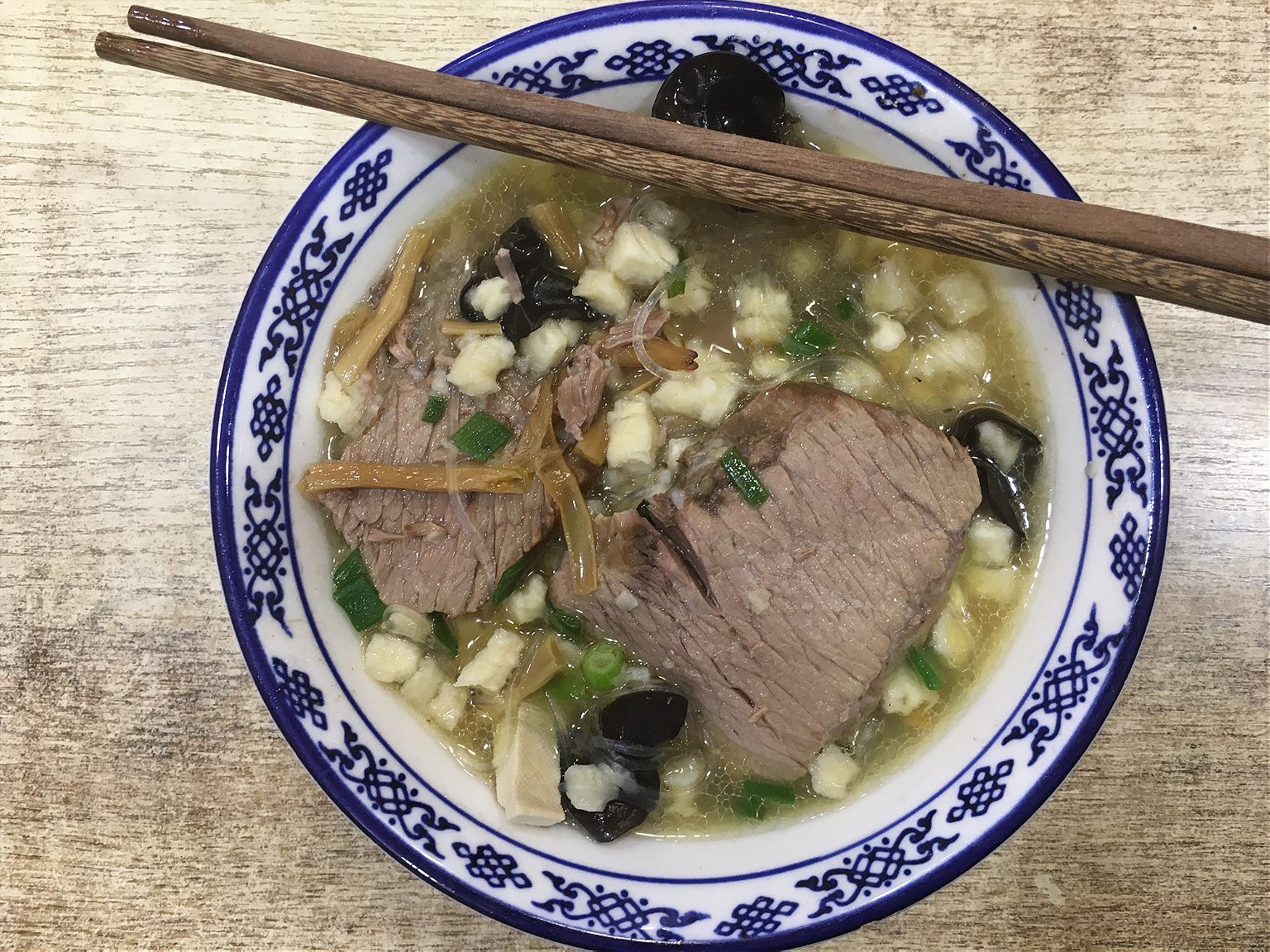
Xi’an has been at the crossroads between the East and West—from a geographic, spiritual and culinary sense—since its founding more than two millennia ago. During the Tang Dynasty (618-907 AD), Xi’an was one of the most important cities in the world—the capital of China, and home to some one million inhabitants. As the terminus of the Silk Road, everything passed through Xi’an (then called Chang’an) on its journey from China to the West, and vice versa. Arab and Persian traders arrived in sizable numbers, introducing Islam, as well as their customs and food. Many stayed and intermarried with Han Chinese, and their descendants now make up the Hui Muslim minority group.
After a long dormant period, Xi’an is once again a vital connection point between East and West as part of President Xi Jinping’s “One Belt, One Road” initiative. A once dusty outpost at the edge of the Gobi Desert, Xi’an is now a standard-issue Chinese megalopolis of some 8.5 million people, complete with car-choked boulevards and a skyline of neon-lit skyscrapers as far as the eye can see (at least when the murky curtain of smog isn’t obscuring the view). As in much of China, the mantra in the new Xi’an is get rich, build higher, move faster.
Few people have time for leisurely two-hour paomo brunches anymore, even in the ramshackle heart of the old Muslim Quarter, and the district is rapidly being encroached upon by the booming megacity that surrounds it.
Related Reads
Located inside the city walls, Xi’an’s Muslim Quarter is home to one of China’s largest mosques and an estimated 65,000 Hui Muslims, crammed into a warren of narrow streets and aging, low-slung homes. At first glance, the district’s main thoroughfare, Huimin Jie (Muslim Street), retains a traditional, laid-back appeal. Women in bedazzled headscarves butcher sides of beef while men in brightly patterned pajama-like outfits known as mian chou grill lamb kebabs on makeshift barbecues, stir cauldrons of simmering beef, and smack gooey handmade noodles like whips against metal countertops. Bleating motorcycles and the full-throated cries of determined restaurant hawkers add to the cacophony. Every now and then, the call to prayer from the local mosque echoes through the streets.
Thrusting their way through the madness now are also mobs of tourists, selfie sticks jabbing the sky. The famed terracotta soldiers aren’t the only tourist trap in Xi’an; Muslim Street, too, has become an attraction in its own right, mainly for the traditional Hui cuisine. As it’s grown in popularity, however, the Hui food vendors’ stalls are being slowly replaced by hawkers selling trinkets and non-local, fast foods like deep-fried squid, which some Hui Muslims don’t consider halal. The fabric of the Muslim Quarter is starting to unravel, many locals say.
As a foreign correspondent who spent six years in China, I’d seen similar historic neighborhoods in Beijing and Shanghai razed and rebuilt as swank shopping centers in a faux-Ming Dynasty style, with Starbucks and Krispy Kreme outlets replacing two-dollar, hole-in-the-wall noodle and dumpling stalls. The Muslim Quarter no doubt faces the same threat, occupying prime real estate in the center of Xi’an, bordered by Dolce & Gabbana and Louis Vuitton. In 2015, hundreds of Hui residents protested—an extreme rarity in tightly controlled China—over the sale of beer in some restaurants and barbecue stalls in the quarter. Residents succeeded in reinforcing the district’s alcohol ban, but it was a sign that change was surely afoot.
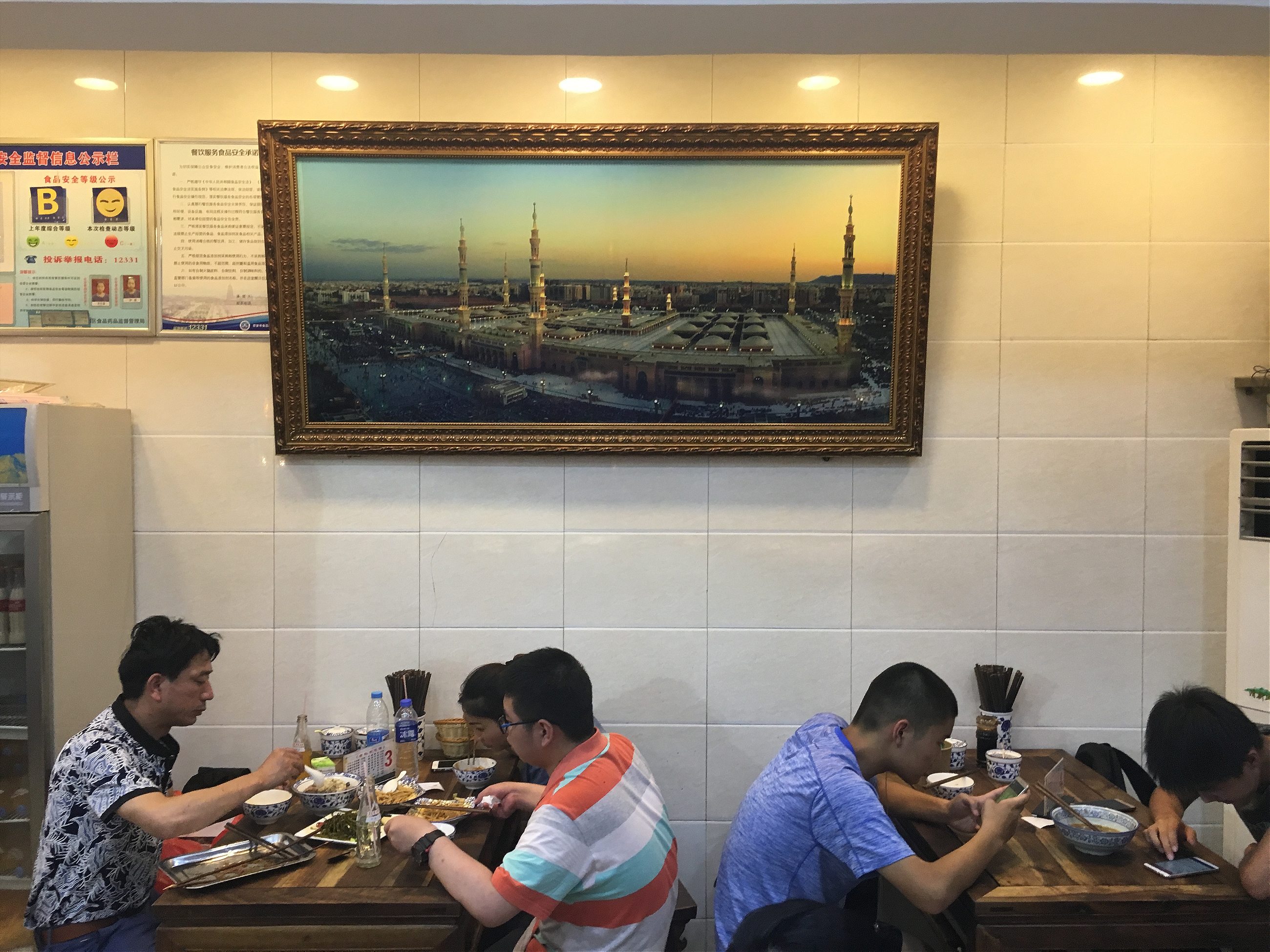
When he was a kid, Liu Chao’s favorite dish was doufu nao, a soupy tofu that looks exactly like its name (tofu brains). He used to buy it from a tricycle cart that passed through the Muslim Quarter every morning, drawing residents out of their homes with bowls and spoons in hand. Liu, now 36, says you can still find doufu nao in Xi’an restaurants, but the taste isn’t quite the same. “The raw ingredients have changed,” he says. “Many things are imported today instead of being grown or made locally.”
Liu has a somber demeanor, spiky black hair, a wispy beard, and a curious scar twisting the entire way around his neck. He’s not a chef himself, but like Demon Brother, he seems to know everything there is to know about Xi’an food. I’d read about Liu in the Global Times, an English-language mouthpiece of the Communist Party. He’d grown up in the Muslim Quarter and, prompted by the recent transformation of the district, started a food tour company in 2013, introducing visitors to authentic Hui cuisine, the kind he remembers from his childhood. I meet him and his friend, Ma Zhaoxu, in a darkened tea house in the Muslim Quarter.
The problem in the Muslim Quarter is a simple matter of supply and demand, Liu tells me. Most of the graceful, gray-brick homes on Muslim Street have belonged to Hui families for generations. And many of families have traditionally made their living in the food industry. But when the tourist trade began to pick up, some locals found that if they rented their shopfronts to cashed-up, outside entrepreneurs, they could retire from the grueling work of running a low-margin restaurant and watch the money come in. Most of their children were turning away from the old hawker businesses anyway. “They don’t want to do the dirtiest, hardest, and most tiring work anymore,” Liu says.
Related Reads
As more locals have sold out to newcomers, rents have skyrocketed, Liu says. He estimates that only about 10 percent of the storefronts on Muslim Street are still run by Hui food vendors. The rest sell what he calls “fast-moving consumer goods”: kitschy souvenirs and snacks like candy and mango juice you can find at every tourist attraction in the country. It’s becoming more difficult to find a halal meal, something Liu finds particularly distressing.
His friend Ma suddenly perks up. Ma, 32, is the son of the local imam and goes by the Arabic name Idris. He has a round face, round belly and round, expressive eyes. He details his plan to keep his family’s persimmon doughnut business alive—for both his love of Hui food, and his love of Islam. He’s a devout Muslim who went to Mecca for the hajj several years earlier. “If our faith is weakened, it’ll be really sad for us,” Idris explains. “That’s why we’re trying to show tourists that the Muslim District is not just about food—it’s our culture, morality and love. This is everything we have.”
We head out into the torpor of the late-afternoon heat so I can sample some of Idris’s doughnuts and feel the love for myself. We wind our way through narrow back alleys back to bustling Muslim Street, ending up in front of a storefront window display stacked high with orange discs the size of hockey pucks. A woman in a pink sequined hijab and bright green, floral dress is wrapping up doughnuts for a group of boys who look like they’re on a school trip, dressed in identical t-shirts with the English words “WOW! MIND” on the front. Idris’s family has run the shop, Yi Gu Zhai, for the last 30 years. His parents have never dreamed of renting the space to outsiders; in fact, Idris is expanding the shop with a small museum devoted to local food culture on the second floor.
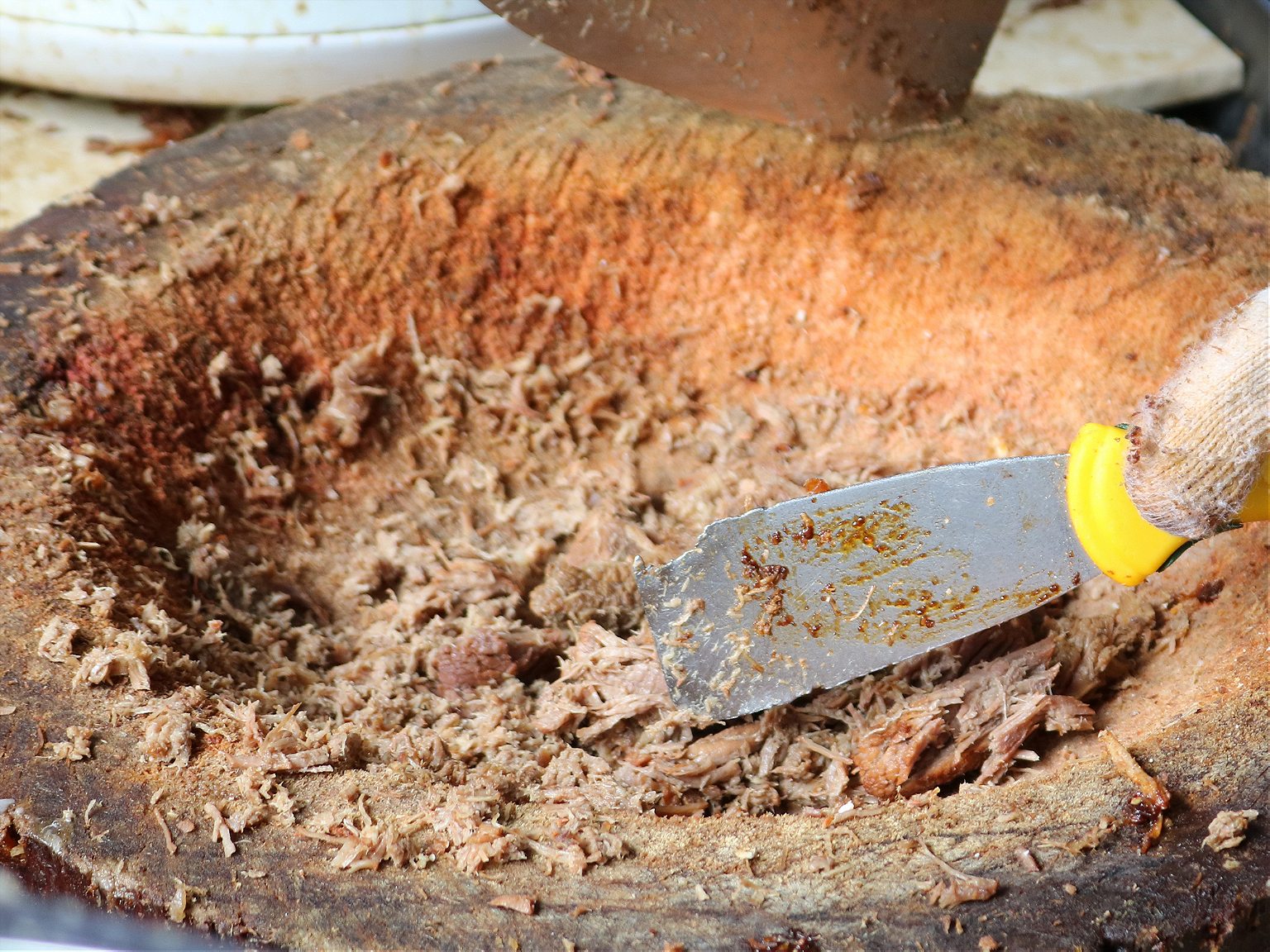
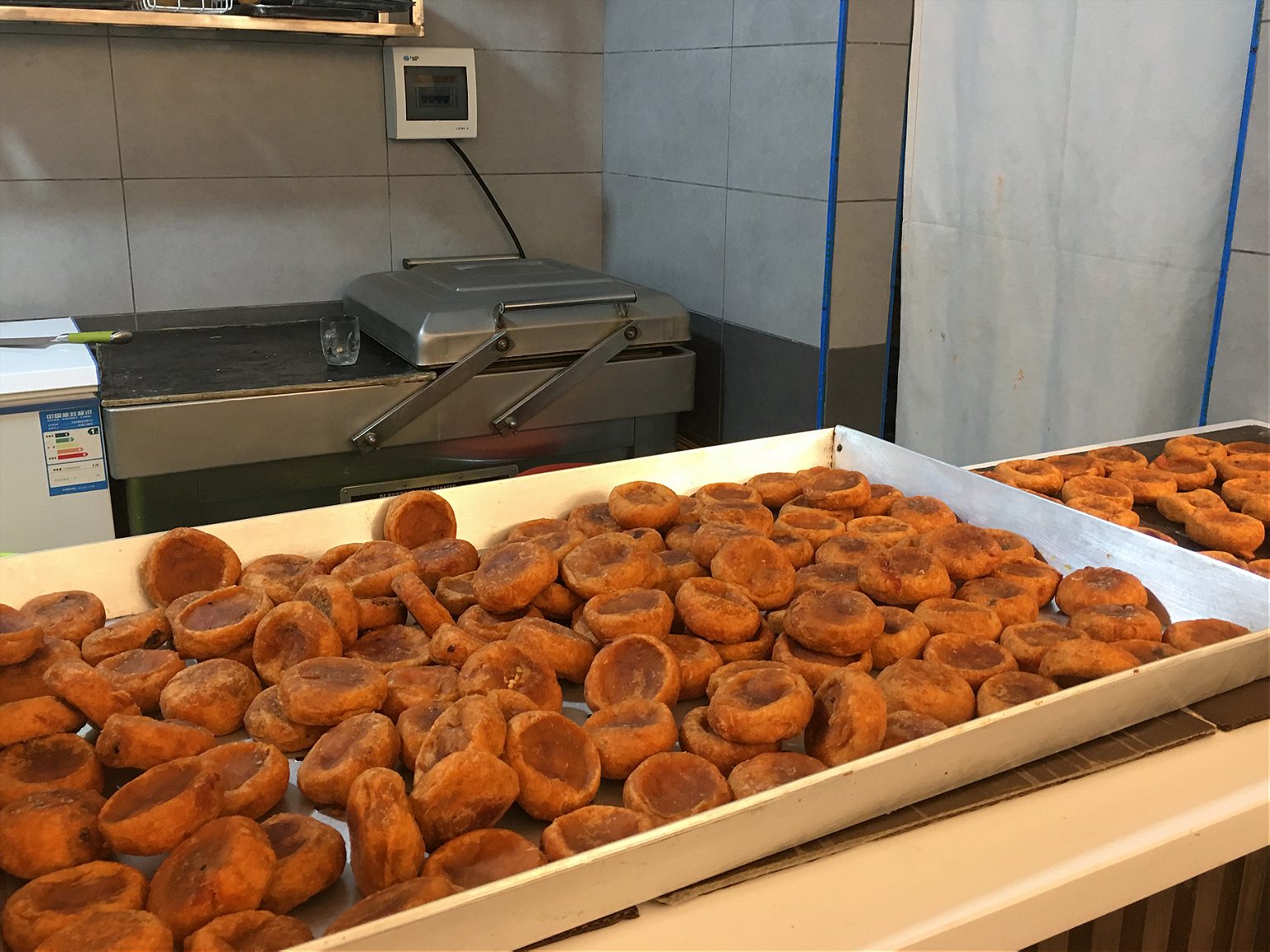
His family uses a special type of local persimmon, called huojing, which he says mixes best with flour. The bakers mash the persimmons into a pulp and knead the gummy substance into dough, which they fill with a mixture of ground peanuts, sesame, walnuts, almonds, sunflower seeds, date and bean paste, and shredded coconut. The doughnuts are then pan-fried until they’re the color of sunset. The taste is heavenly, much lighter than I imagined.
Idris wants to show other Hui homeowners the value of keeping old recipes alive, even if it means giving up big profits. There’s an old saying that drives him: Hui hui shi bao, which translates roughly as ‘Hui people can recognize treasure.’ “The meaning, I reckon, is that Hui people can really appreciate the history of things,” he says.
Later on, Liu takes me to meet another friend, Bai Lin, 47, who runs one of the Muslim Quarter’s most well-known roujiamo restaurants, Lao Bai Jia Pao Mo. Along with paomo, roujiamo is considered one of Xi’an’s most iconic street foods—a highly addictive bread pocket bulging with lamb or beef (or in other parts of the world, pork) that’s been stewed for hours in a spicy broth. Bai, who also grew up in the neighborhood, opened his place 20 years ago. He says he learned his recipe from his grandfather, who was a cook in a state-run cafeteria in the 1970s.
We won’t even know what to eat outside the Muslim District.
“The neighborhood has changed a lot,” he says as we sit down before the dinner rush. He’s dressed in a loose-fitting black t-shirt and pants and wears a beaded brown prayer cap. There’s not a drop of sweat on his brow. “But those with steady faith run their businesses carefully and will follow the customs of generations past.”
The chefs at Bai Lin’s restaurant cook on the street. To the right of the entrance is a massive silver cauldron, where beef stews for up to four hours in a broth flavored with Sichuan peppercorns, fennel, star anise, cinnamon, and black cardamom. When it’s done, a younger chef pulverizes the meat with a curved knife on a concave chopping board until it’s flaky and tender. He’s obviously the workhorse of the operation. Rail-thin and unsmiling, with long swathes of sweaty hair matted to his forehead, the chef’s knife-wielding hand never stops dancing over the rutted stump of wood. The persistent tapping sounds are like a woodpecker that just won’t quit.
A line of ten people forms in front of the chopping dynamo, but Bai Lin swoops in and scores a burger for me, wrapped in a thin brown paper bag. The bread is baked fresh every morning at 4 a.m. and then quickly steamed before serving to retain some of its moisture—a trick Bai Lin learned to avoid it drying out. The pocket is crisp, like an oven-baked cracker. Before I realize it, I’ve devoured the entire thing and washed it down with a Xi’an orange soda called Ice Peak.
Back on the street, surrounded by shops selling silver trinkets and tacky caricatures of tourists, Liu says there’s another reason it’s vital for culinary foot soldiers like Bai Lin to so doggedly preserve Hui food culture. If the vendors disappear, the next generation will grow up without authentic halal food. “We won’t even know what to eat outside the Muslim District,” he says. I see what he means the next day when I visit a food court in a mall near my hotel. It’s chock-full of Xi’an street food classics—roujiamo, paomo, liangpi(cold noodles topped with a spicy, sesame sauce)—prepared fresh by chefs wearing aprons and hygiene masks over their mouths. Uniformed women circle with carts to whisk up dirty plates. There’s air conditioning, English signage, and soft lighting. And the place is packed. But when I ask the cashier about halal options, I get a perplexed look. There’s only one vendor, she says, motioning off in the distance. Next to her is a chef preparing pig’s trotters—not the warmest welcome for Hui clientele.
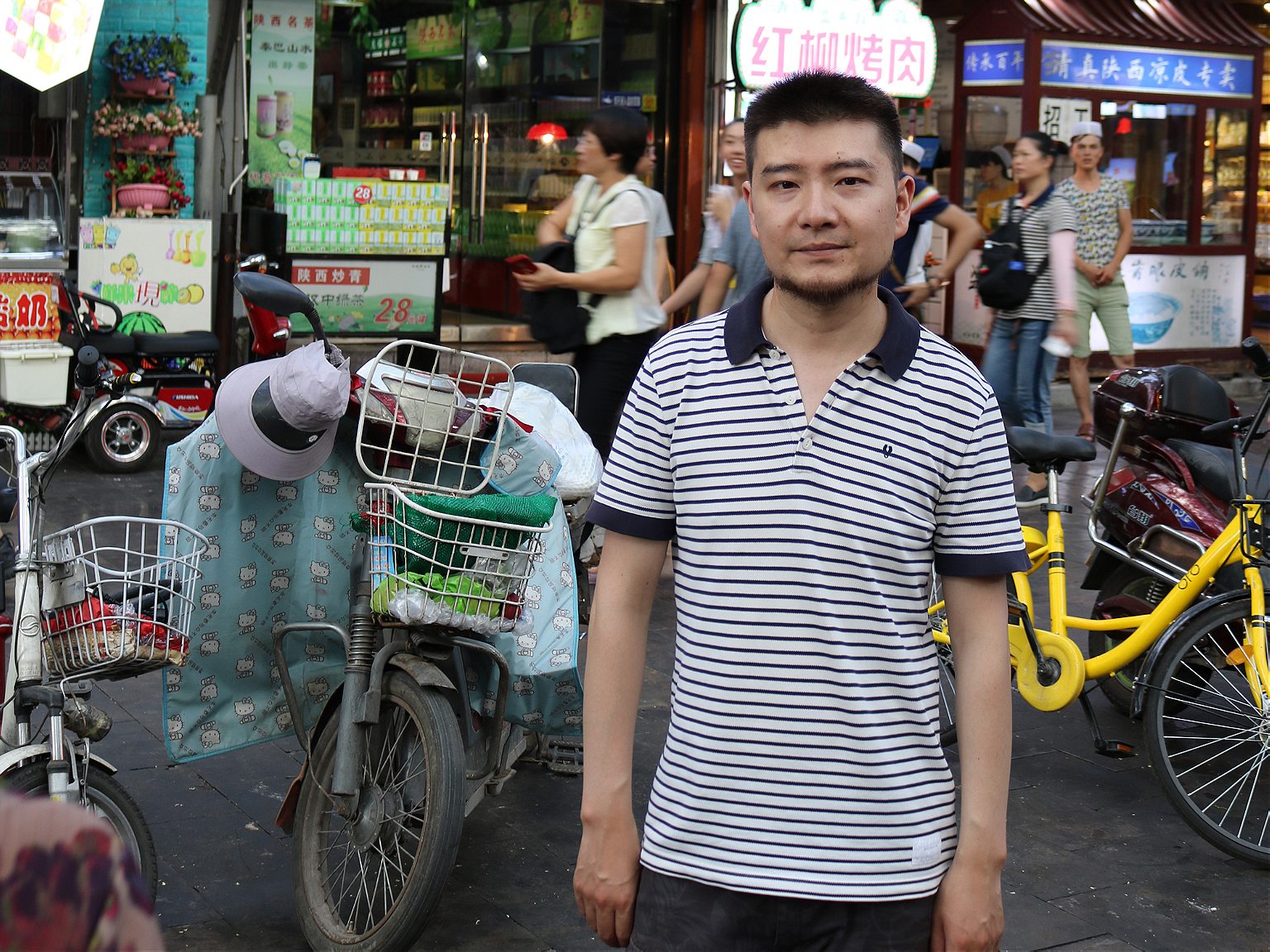
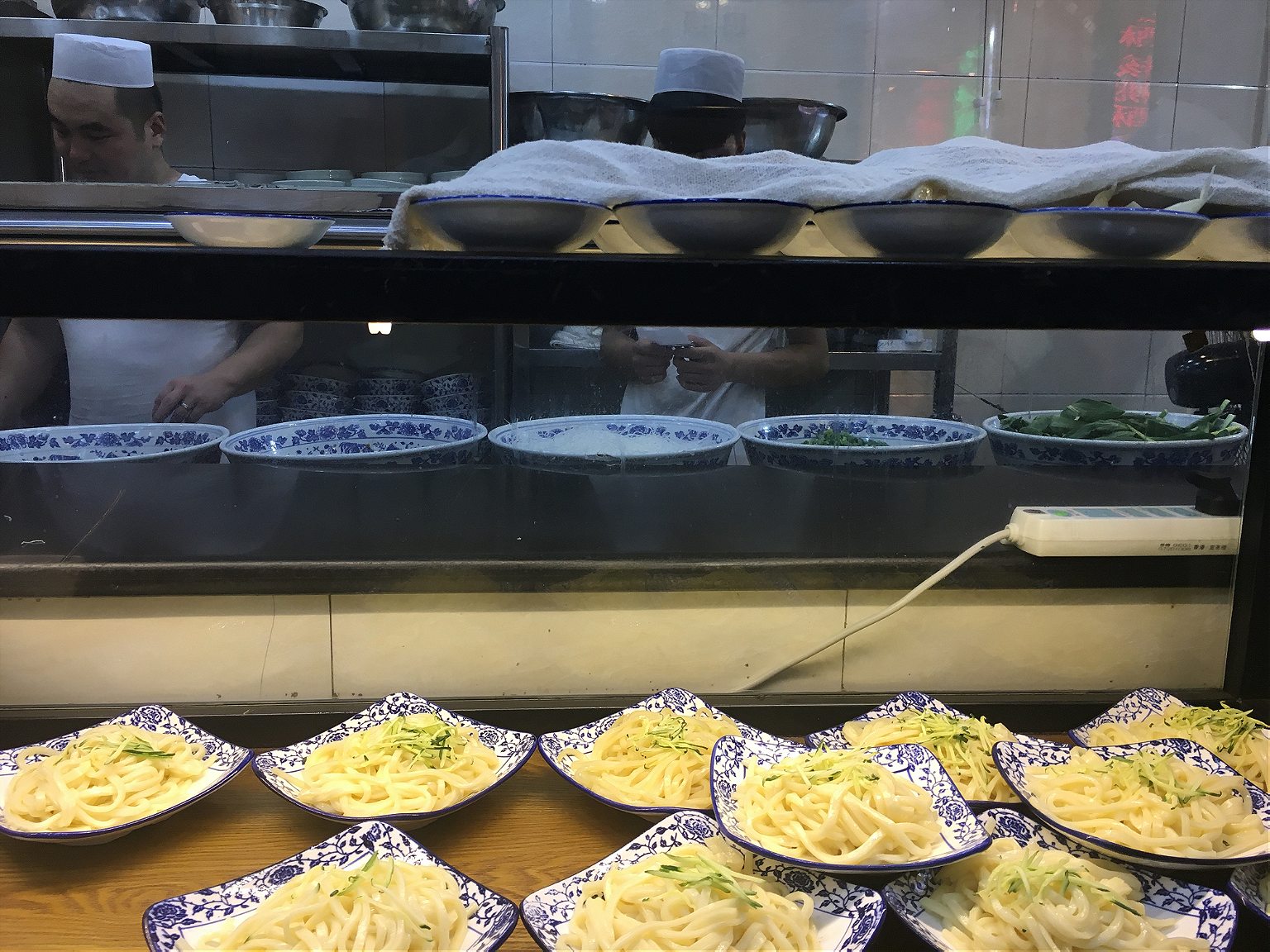
While Liu has been trying to to bring awareness to traditional Hui foods at the street level, Demon Brother has been trumpeting the glories of the cuisine on a daily basis to his 1.1 million followers on Weibo, the Chinese version of Twitter. Demon Brother is not from Xi’an—he was born in the coastal province of Shandong. Nor was he ever a chef. But in a short span, he’s established himself as the most trusted food writer in this part of China, an encyclopedia of Xi’an cooking and culinary history. For years, he had a popular food program on Shaanxi provincial television, and as his reputation grew with his Weibo food blog, he became a frequent guest on national food and travel shows. CCTV, China’s state broadcaster, once referred to him as “Xi’an’s No. 1 foodie.”
I get a sense for Demon Brother’s renown when he arrives for our food tour, dressed casually in a t-shirt and shorts, and driving a Mercedes SUV. We wander into the Muslim Quarter together, down a quiet street away from the hubbub of the tourist zone, and stop at a cart for some liang gao, rice cakes topped with honey and rose petals. The vendor takes one look at Demon Brother and his eyes grow wide. He points to a photo taped to the glass of his cart—it’s none other than Demon Brother, clipped from a news article. He then asks Demon Brother to pose for a selfie with him, which my guide obliges.
It’s early evening and the sky is turning an ominous black as a summer storm approaches. Huge drops of rain soon start to fall and we take cover under an awning at a dumpling restaurant. Demon Brother disappears for a few minutes and returns with our next course: Xi’an-style soup dumplings, or tangbao. Unlike the more celebrated xiaolongbao found in Shanghai, Xi’an’s soup dumplings don’t rely on pork aspic to create the savory broth. Rather, Xi’an dumplings are stuffed with beef or mutton, which release their own juices when steamed to produce the same effect. As we dig in, the rain begins coming down in sheets, sending all the street food chefs scurrying to protect their carts.
I ask Demon Brother whether he fears a district-wide government redevelopment scheme. There’s some demolition happening in the Muslim Quarter already, he says, but he thinks the compensation local residents would demand would be too high for the government to push them all out. The current renovations are needed to spruce up the place. “The residents will move to a new place temporarily, then move back after the transformation,” he says.
I’m doubtful of this, but he believes the savvier restaurant owners will continue to thrive. Some of the more well-known paomo shops have already started building up their brands and branching out with chains all over the city, he explains. I took Demon Brother for a hard-core traditionalist who would frown at the very idea of “Big Paomo” replacing all the plucky little guys. But he sounds resigned to the fact that Xi’an is changing and the food culture will need to change with it. Some of the bigger paomo restaurants, for example, have outsourced the all-important bread- and broth-making to other producers, he says. In fact, few customers bother to tear their own bread into their bowls anymore. Most chains offer pre-packaged bread chunks made in factories.
Related Reads
After mincing our bread the old-fashioned way at Demon Brother’s favorite paomo restaurant, our last stop on the tour, he shares with me a final secret before we relinquish our bowls to the chef. Place a larger chunk of bread on top to mark your paomo, he tells me. “The chef will prepare it more conscientiously,” he says. It’s clear from the look on his face, though, this step is probably unnecessary—the chef will know which one is mine. “You did not do a good job tearing the bread,” he chides me with a laugh.
Then, Demon Brother grabs both bowls and makes a beeline for the street. I rush after him, stumbling into the moist, sticky night. He barrels into the narrow kitchen next door, mumbling a few instructions to the chef. The chef doesn’t appear to make a judgement either way about the bread; he just lights a flame beneath the wok, adds the bone stock and starts sloshing the boiling liquid around with a ladle before launching the stew skyward with a quick flip at the end. Within minutes, we’re back at our table, in our original restaurant, with steaming bowls of soup before us.
Demon Brother rattles off the names of venerable paomo restaurants on Muslim Street, each with a history stretching back to pre-Mao times (and one going back even further to the Qing Dynasty). Some young Hui are also bucking the trend and choosing to go into the family businesses, he says. “The son of this restaurant graduated from the Communication University of China. But he realized the paomo business could make money so he came back.” In between slurps of noodles, Demon Brother then becomes sentimental, telling me how paomo is still so central to the identity of Xi’an—and its people.
“The bread has a hard core. It’s like Shaanxi people’s character— ‘sheng, leng, ying, ceng’ (crude, frosty, tough, quick to rebuke),” he says. “But the bean vermicelli and meat are soft and easy to chew, and Shaanxi people can, at times, be tender and soft as water.”
“What else do you want to know about paomo?” he asks as we both near the bottoms of our bowls. “There are still a lot of things I have not covered.”
I realize he could probably talk all night. “You’ve told me everything,” I say.
“I will talk about dumplings then.” And with that, he flags down the waitress to order more food. And I settle in for a long night.
Rui Zhao contributed to this report.






